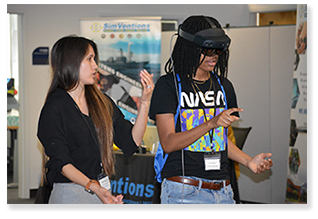Faculty Advisor/Mentor
Yuzhong Shen
Location
Virginia Modeling, Analysis and Simulation Center, Room 2100
Conference Title
Modeling, Simulation and Visualization Student Capstone Conference 2023
Conference Track
Education & Training
Document Type
Paper
Abstract
Currently there is no low-cost solution to teach large quantities of Naval Aviators on how to correctly breath on an oxygen mask. This report will discuss the design and implementation of a mask-on breathing apparatus for use with United States Naval Aircrew for initial and annual familiarization. With the current uptick in physiological episodes within the naval aviation enterprise, there has been a need to find solutions to this problem. Currently when a naval aircrew is trained in aviation physiological threats, they do so with normobaric hypoxia tools in the form of the 9A19 Normobaric Hypoxia Trainer for aircrew who do not normally wear a mask during flight and the 9A17 Mask-on Breathing Trainer which is for aircrew who do wear a mask throughout an entire flight. This training evolution only lasts around 15 minutes for each student and does not go over the proper breathing techniques to use to breath while on mask provided oxygen. It would take too long and would be overly costly to use the existing training methods to perform this task. The goal of this project is to rectify the gap in training by providing a low cost means to give positive feedback training to large numbers of students at once.
Keywords:
Hypoxia, Naval aviation, Aviation training, Aerospace physiology
Start Date
4-20-2023
End Date
4-20-2023
Recommended Citation
Larson, Robert and Shen, Yuzhong, "Mask-on Breathing Awareness Trainer (MOBAT)" (2023). Modeling, Simulation and Visualization Student Capstone Conference. 3.
https://digitalcommons.odu.edu/msvcapstone/2023/educationandtraining/3
DOI
10.25776/xm53-vt33
Mask-on Breathing Awareness Trainer (MOBAT)
Virginia Modeling, Analysis and Simulation Center, Room 2100
Currently there is no low-cost solution to teach large quantities of Naval Aviators on how to correctly breath on an oxygen mask. This report will discuss the design and implementation of a mask-on breathing apparatus for use with United States Naval Aircrew for initial and annual familiarization. With the current uptick in physiological episodes within the naval aviation enterprise, there has been a need to find solutions to this problem. Currently when a naval aircrew is trained in aviation physiological threats, they do so with normobaric hypoxia tools in the form of the 9A19 Normobaric Hypoxia Trainer for aircrew who do not normally wear a mask during flight and the 9A17 Mask-on Breathing Trainer which is for aircrew who do wear a mask throughout an entire flight. This training evolution only lasts around 15 minutes for each student and does not go over the proper breathing techniques to use to breath while on mask provided oxygen. It would take too long and would be overly costly to use the existing training methods to perform this task. The goal of this project is to rectify the gap in training by providing a low cost means to give positive feedback training to large numbers of students at once.

